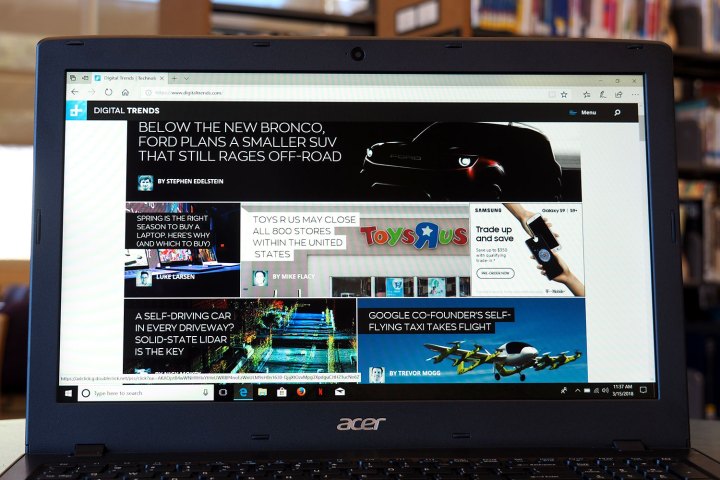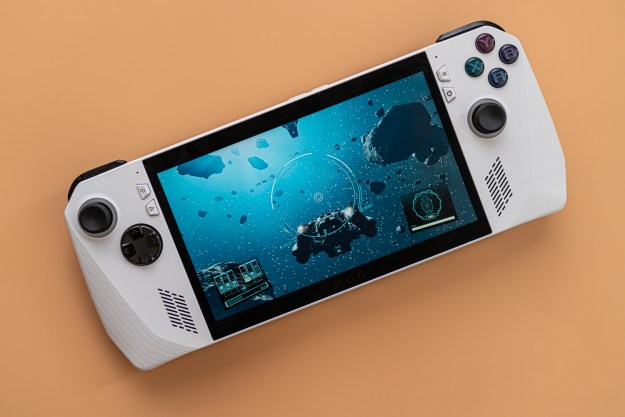
Buying a notebook can be a challenging proposition. So many choices, so little time and money to choose among them. That’s no less true if you’re spending $500 instead of $1,500 or more, as even budget notebooks can vary in quality, performance, and features as much, if not more so, as can premium notebooks.
Acer’s Aspire 3 is a case in point. It’s one of a handful of budget notebooks the company offers, a few of which we reviewed in 2018. Yet while the Aspire 3 might share the pedigree of standout budget offerings like Acer’s Aspire E 15, it’s not nearly as good as its peers.
To illustrate the point, we evaluated a $530 configuration of the Aspire 3, equipped with an AMD Ryzen 5 2500U CPU with Vega 8 graphics, 8GB of RAM, and a 256GB SATA solid-state drive. That’s a good price for the components inside. We’ll compare the Aspire 3 to our favorite budget notebook, the Aspire E 15, that runs $570 for an 8th-gen quad-core Intel Core i5-8250U, Nvidia GeForce MX150 GPU, 8GB of RAM, and a 256GB SATA SSD.
The retail prices are close enough that a buyer wouldn’t want to compromise just to save a little money. You can find the Aspire 3 for closer to $450 if you look around, but even so if you’re choosing between these two, some real differences make the Aspire E 15 a much better choice.
Inexpensive shouldn’t mean cheap
Most budget notebooks are classic in plastic over a thin metal chassis. That doesn’t have to be a bad thing, though, as the Aspire E 15 demonstrates. While the Aspire 3 suffers from tons of flexing and bending throughout its lid, keyboard deck, and chassis, the Aspire E 15 is much more solid.

That’s most apparent in the keyboard deck, where the Aspire E 15 has a layer of metal that provides it with extra rigidity. The Aspire 3’s keyboard deck is too springy and makes typing feel like pounding on a snare drum. The keyboard mechanisms might be roughly the same on both notebooks, but the Aspire E 15 is much more comfortable for long typing sessions.
The Aspire 3’s lid is also bendy, giving in to light pressure on the Acer logo located in the center. The bottom of the chassis feels too loose. Overall, the Aspire E 15 is much more robust. You’d want to grab hold of both in a retail store to discern the difference before pulling out your credit card.
Don’t subject your eyes to this
Budget notebooks rarely have the best displays. They sometimes come with old-school TN panels that don’t offer the viewing angles accorded by the better, and now very common, IPS display technology. Color and contrast also suffer with a TN panel, as does brightness. Sometimes, you can tell a notebook has a lower quality display the second you turn it on.
The Aspire 3 has a truly bad display even by historical standards.
However, not all budget displays are the same. The Aspire 3 has a truly bad display even by historical standards. To begin with, it has terrible viewing angles that hint at a TN panel (or a very low-quality IPS display), and it’s also low-resolution by modern standards at 1,366 x 768. That makes text quite grainy given the panel’s 15.6-inch size. Color gamut is low at just 41 percent of AdobeRGB, as we’d expect on a budget notebook, and accuracy is very poor at 8.63 (less than 1.0 is considered excellent). Finally, brightness tops out at 200 nits, and the contrast ratio is an appalling 70:1.
Compare this to the Aspire E 15. To begin with, its display is Full HD (1,920 x 1,080), so it’s considerably sharper. Viewing angles are much better thanks to its use of an IPS panel, and while the color gamut is similar at 47 percent of AdobeRGB, color accuracy is much better at 2.02. It’s not as bright at 173 nits, but its contrast is very good at 960:1.
All of this adds up to a predictable subjective experience. To put it bluntly, the Aspire 3’s display looks horrible. Poor resolution, terrible contrast, and low brightness means it’s dull and unpleasant for just about any use. The Aspire E 15’s display, on the other hand, is fine for both productivity and watching Netflix. Creative types who demand wide color gamuts and perfect accuracy should look elsewhere, but the Aspire E 15 provides a far better experience at similar cost.
Basic, long-lasting productivity is today’s entry level
The Aspire 3 also can’t keep up with the Aspire E 15 in performance. That’s due to the former’s AMD Ryzen 5 2500U CPU that suffers when compared against the latter’s Intel Core i5-8250U. Both are quad-core processors that run at similar clock speeds, but the AMD chip is considerably slower in our tests.
Not only is the Aspire E 15 faster than the Aspire 3, but it can also last closer to a full working day away from a charger.
Looking at Geekbench 4, the Aspire 3 is quick enough in the single-core test, but it’s well behind in the multi-core test. It will be fast enough for basic day-to-day use, but it’s going to fall behind as you start performing multiple tasks at once. In our Handbrake test that converts a 420MB video from h.264 to h.265, the Aspire 3 takes almost 25 percent longer to finish. That’s a difference you’d notice.
The result is a notebook that’s considerably slower than the Aspire E 15. And to add insult to injury, the Aspire 3’s battery life is significantly worse, thanks to a smaller 37 watt-hour battery compared to 62 watt-hours in the slightly more expensive machine. No matter which our tests you look at, the Aspire E 15 lasted almost twice as long.
Once again, there’s a lot more than $40 worth of difference between these two notebooks. Not only is the Aspire E 15 faster than the Aspire 3, but it can also last closer to a full working day away from a charger.
You’ll want to do your research even if your wallet is thin
The lesson here is obvious. Do your research before you make your investment and remember that modern laptops last longer than they used to. Even a budget model should still be functional five to seven years from now. If you buy the right one.
We’ve just looked at two budget notebooks here, and we could easily have expanded our comparison to include others like the Acer Aspire 5 and the Lenovo IdeaPad 530s. Those, too, are better notebooks for similar or just a bit more money.
The stakes might be lower if you’re spending well under $1,000 for a notebook, but the consequences can be just as severe. If you were to choose the Aspire 3 over the Aspire E 15, then you’d regret it – and that’s not how you want to feel no matter how much money you spend.
Editors' Recommendations
- Don’t buy the Surface Laptop Go 3 — here’s what you should get instead
- This bike desk lets you power your laptop with your workout




